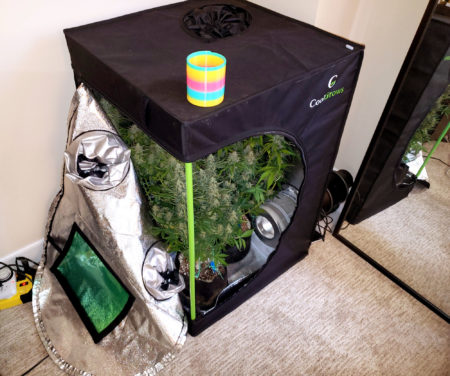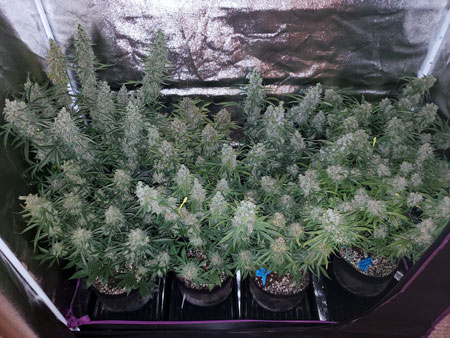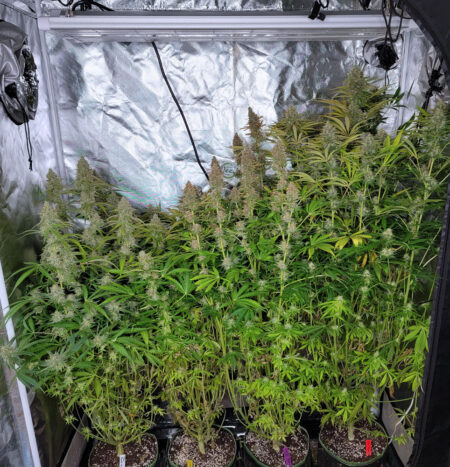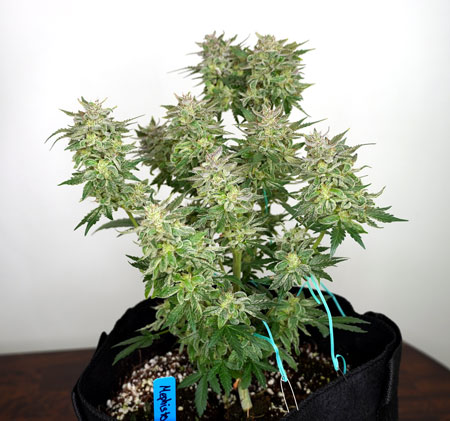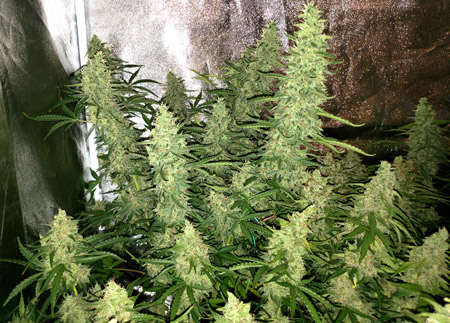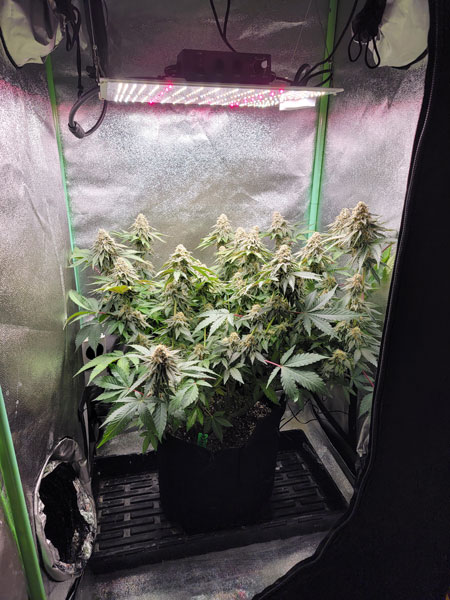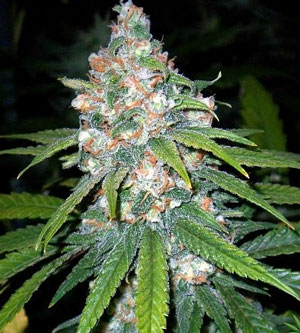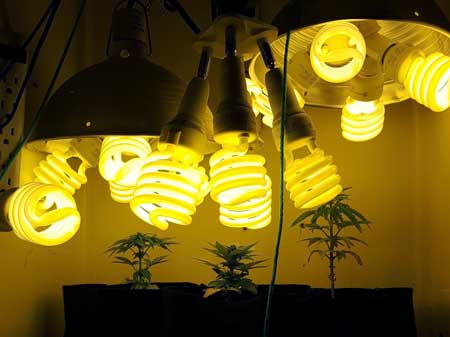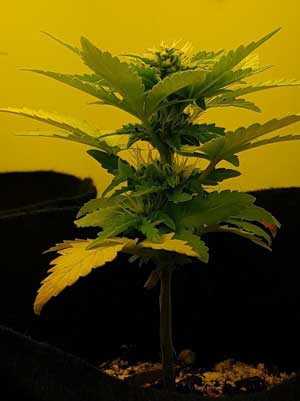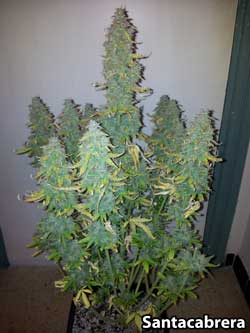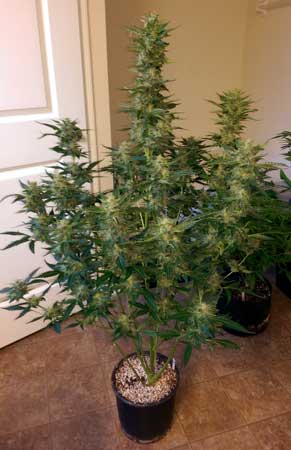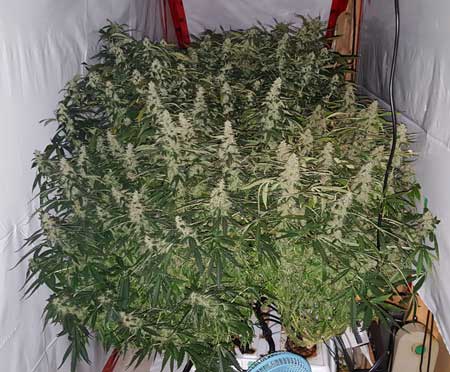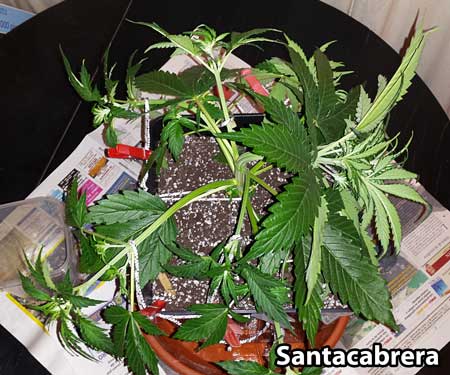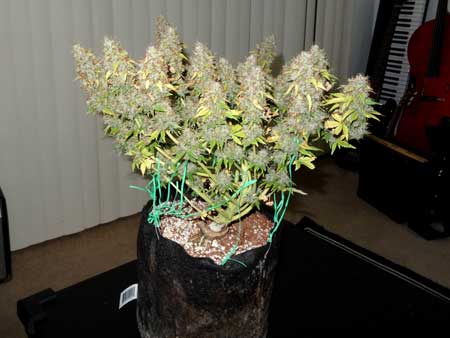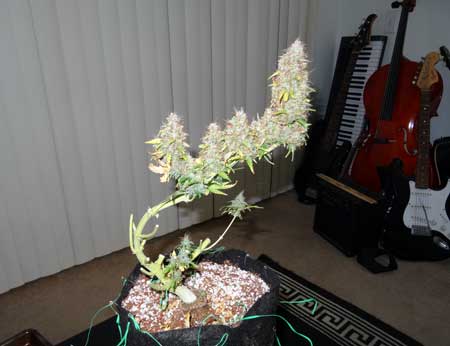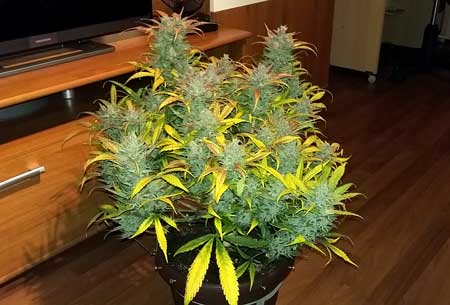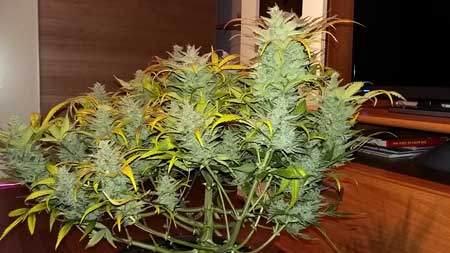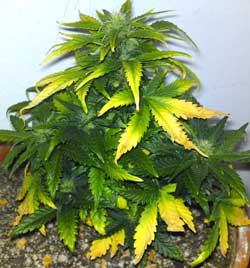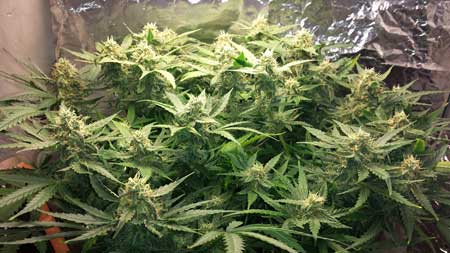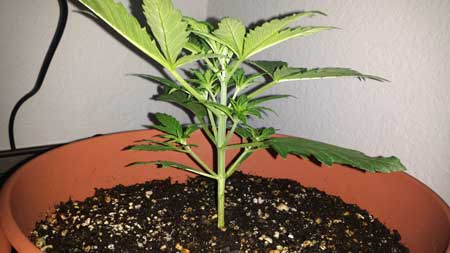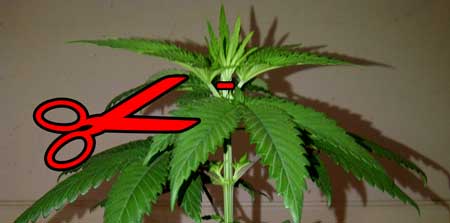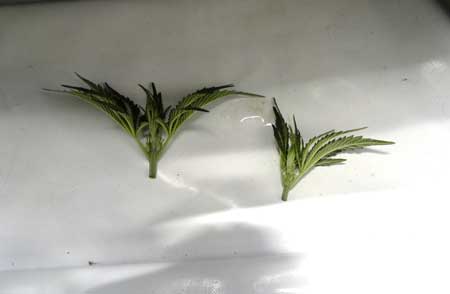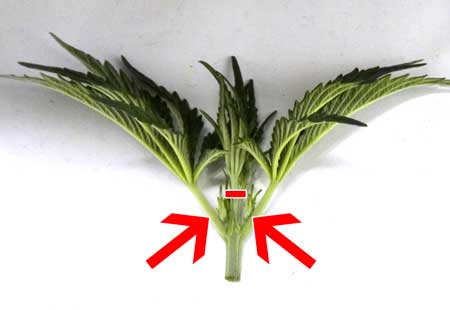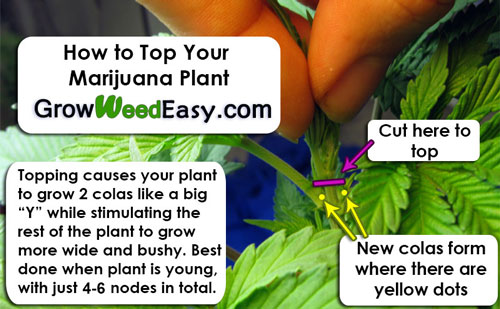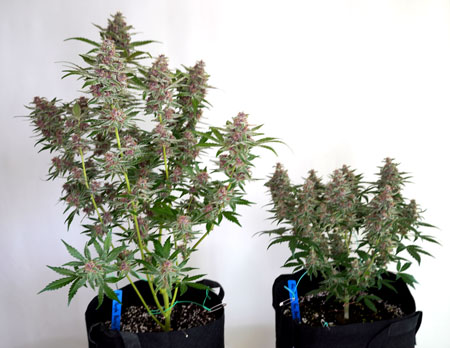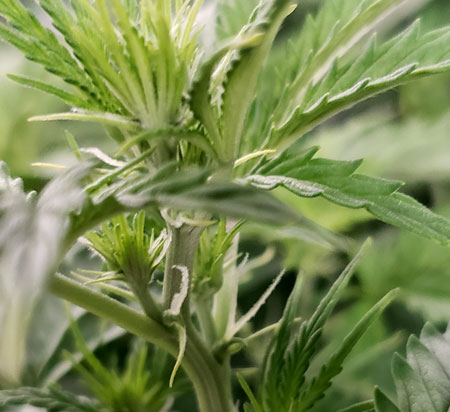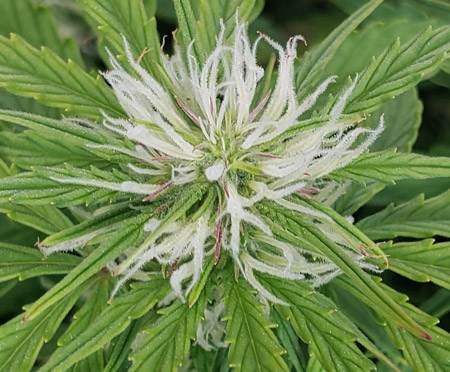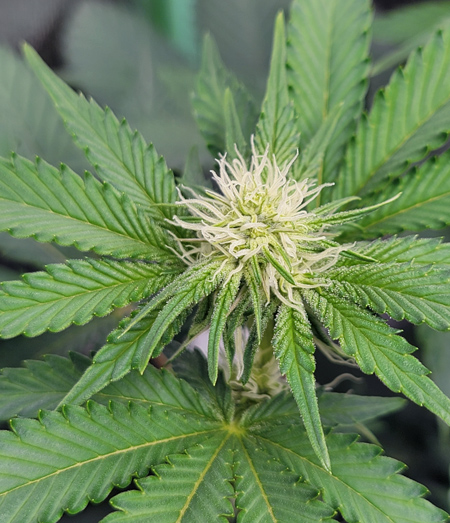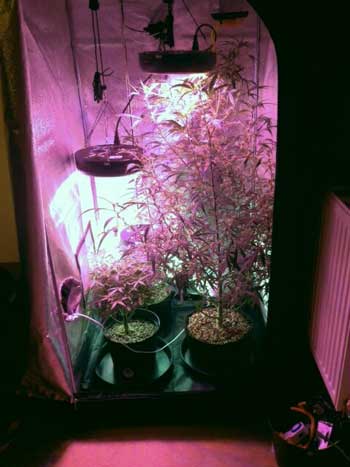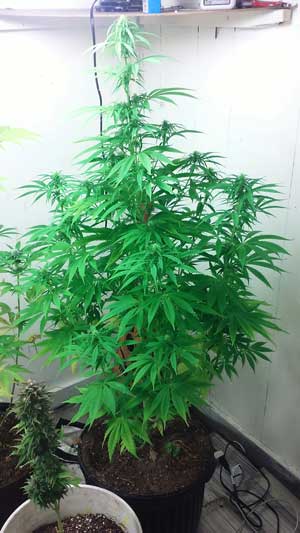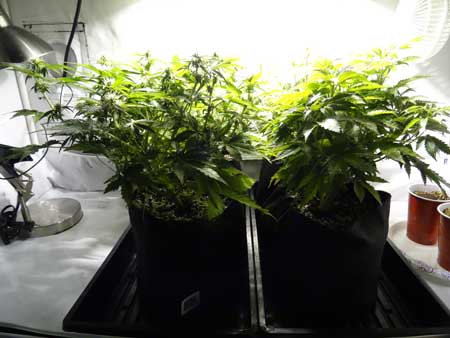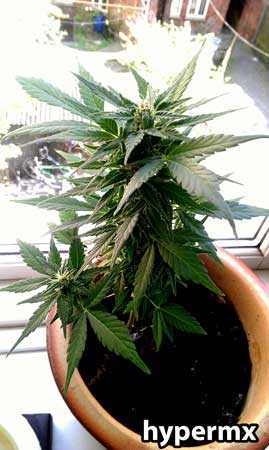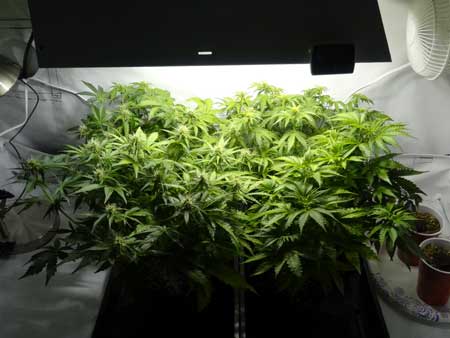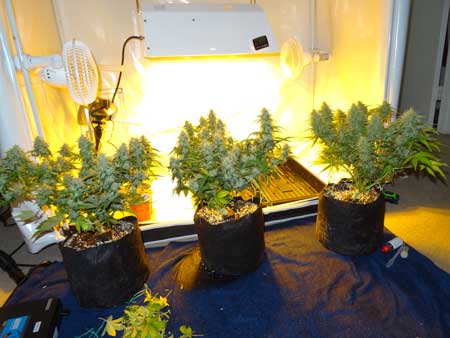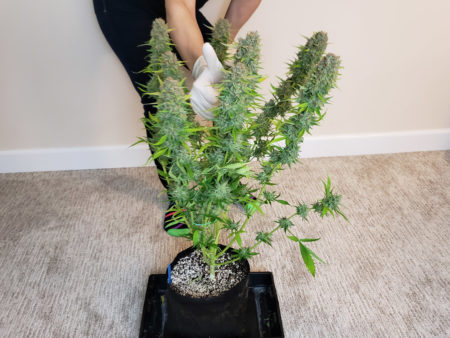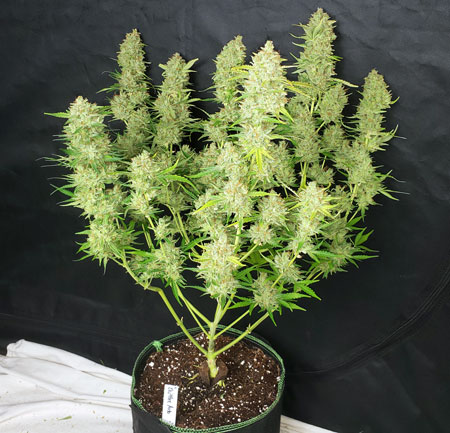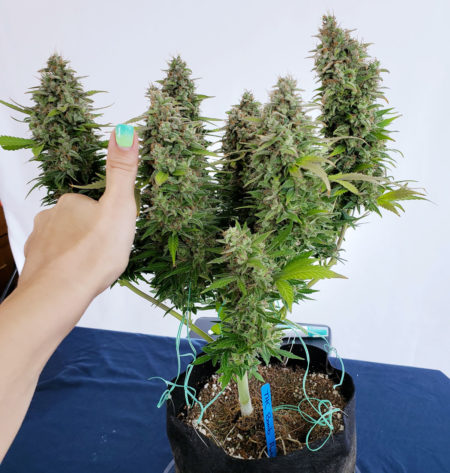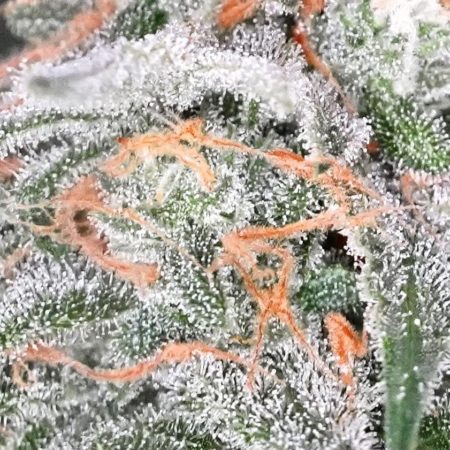by Nebula Haze
Plant Training Methods to Increase Auto-Flowering Strain Yields
For those who don’t know: An auto-flowering marijuana plant automatically starts making buds about 3-5 weeks from seed germination (depending on the strain). Most autoflowering plants are ready to harvest by the time they’re just 2-3 months old, much faster than other cannabis strains. Unlike standard (“photoperiod”) strains, auto-flowering strains also don’t need special light schedules to make buds. You give the plants light, water, and nutrients, then wait until the buds are ready to harvest. Note: You probably won’t find auto-flowering seeds in your buds so you’ll need to buy them from a reputable breeder (check out the list of recommended auto-flowering breeders below).
Today’s cannabis training tutorial will teach you how to grow autoflowering plants like this
And this (grow a sea of buds!)
Never wild like this
Never stunted with small yields like this
Today you’ll learn how to grow big fat autoflowering buds!
The quick-yet-bountiful harvest is one of the biggest benefits of growing auto-flowering marijuana plants. However, the shortened vegetative stage brings up an important question. Generally, when growing photoperiod cannabis strains, indoor growers use plant training methods for the first 4-6 weeks of a plant’s life to make plants grow flat and maximize yields in the flowering stage.
Can auto-flowering plants be “trained” in their short vegetative stage? And if they can be trained, does it actually provide any benefits? The short answer is “yes” to both questions (with one caveat).
If Auto-Flowering Plants Are Healthy, They Usually Respond Well to “Topping” or Low-Stress Training
This gorgeous Runtz auto-flowering plant was topped at a young age and produced several ounces under a tiny 100W LED grow light (a Spider Farmer SF-1000). Here’s the full setup I used.
Auto-flowering strains can be trained to produce more and bigger colas, and proper plant training can increase yields and overall improve your grow results.
See 10 Recommended Auto-Flowering Cannabis Breeders
(plus several suggested autoflowering strains)
Auto-flowering strains from a decade ago were heavily hybridized with wild hemp and produced small and subpar-quality flowers. However, modern auto-flowering strains from trustworthy breeders (like this Auto Lemon OG Haze plant from breeder Nirvana) produce buds that are just as potent and beautiful as traditional photoperiod strains.
3 Main Schools of Thought on Auto-Flower Training
There are 3 main schools of thought about what works best when it comes to training auto-flowering cannabis plants. Each has pros and cons:
- No Training at All – Since autos only stay in the vegetative stage for a few weeks, if you stress your plant too much with extensive training, it may end up stunted. A stunted auto-flowering plant produces very low yields. As a result, many growers recommend no training at all when it comes to auto-flowering marijuana strains, just to be safe. Untrained plants still produce a lot of bud!
- Low Stress Training Only (Bending) – The idea behind low stress training is to force the plant into the flat shape you want by bending all new stems and tying them down. The advantage of sticking only to bending is it’s very low stress (hence the name) on the plant. There’s basically no chance of stunting from simple bending. However, with LST you don’t have the same full control over the plant’s shape as you do when you actually “top” the plant (split the main cola into two), which makes it very easy to grow a wide and flat plant.
- “Top” the Plant in Addition to Other Training – Modern auto-flowering strains often respond well to “topping”. This is when you cut off the very top of the main stem when the plant has only a few nodes, so that it grows two main stems instead of just one. This makes it easy to spread out the plant under the light. Topping usually won’t stress your plant if it’s healthy and fast-growing, but it’s possible that topping may contribute to stress or stunting if your plant is slow growing or sickly.
Most growers agree you don’t want to do aggressive training on an auto-flowering plant, for example you probably wouldn’t want to make a full manifold, which takes several weeks in the vegetative stage to set up. Though there are exceptions, you usually don’t have enough time in the vegetative stage to take full advantage of that kind of training technique with auto-flowering plants.
Example of a Stunted Auto-Flowering Plant
These auto-flowering plants were stunted when they were young by heat and overwatering. Now they’ve already started flowering and are just a few weeks from harvest.
Even though they have a plentiful amount of light, at this point the plants are not going to get any bigger no matter what the grower does because the vegetative stage is over, and the flowering stage is already under way.
Here’s a closeup of the middle plant. You can see by the bud development that it’s just a few weeks from harvest. Since it’s this far into the flowering stage, you know that the plant is not going to get any bigger. The buds will fatten up, but even if they tripled in size, the grower would only get a few grams of bud. The plant just isn’t big enough to support bigger yields.
This is why many growers recommend no training for auto-flowering plants. They’re trying to avoid stunting. But in the above example, the plants weren’t even topped. They were stunted from heat and overwatering, not training. So, I think the main point is to avoid stressing the plant when it’s young, not something as black and white as “no training allowed.”
Untrained Auto-Flowering Plants
Here are examples of untrained auto-flowering plants. With good care and a strong grow light, they can produce a whole lot of bud without any training, especially if you have some extra height to spare.
These 5 auto-flowering plants were started at the same time. Without any training, they grew into this sea of buds at harvest! Growing many untrained plants together can be one of the easiest ways to get to a quick, hefty harvest. This style of growing is known as Sea of Green and is very well suited to auto-flowering strains.
Low Stress Training on Autos
Here’s an example of LSTing (Low Stress Training) an auto-flowering plant by bending over the main cola when it was young and still mostly in the vegetative stage.
This allows the plant to be spread out in a way that’s somewhat similar to the result of topping
This auto also wasn’t topped. I only used bending and securing to try to keep it wide with many colas. I was happy in the end with the shape, but it was a big pain trying to keep it flat. It’s just a lot easier to keep plants flat when you top them, since it splits them and you can lay each side flat.
Without topping you end up making a “spiral” with the main stem to keep it as short as the rest. Here’s the “skeleton” of that plant to give you a better idea of what the training looked like underneath
An auto-flowering Super Skunk plant just before harvest – this plant spent a little over 2.5 months under a Mars LED grow light.
A view from the side of the same plant. Only LST/bending was used to keep it short and wide, and as a result, you can see there’s still one dominant cola higher than the rest, even though the plant has been completely bent over.
Topping an Auto-Flowering Plant?
If you cut off the very top of a young, fast-growing auto-flowering plant, it may not even notice. Many growers recommend against topping an auto plant because stress can stunt your plant. While you definitely want to avoid stunting, I personally think topping autos works well as long as you make sure your plant is healthy and fast-growing first.
To be honest, other factors like overwatering or a poor environment seem to be much more likely to stunt an auto-flowering plant than topping, especially if you’re cutting off just the very tip of the plant without removing much plant matter.
Overwatering or a poor environment is far more likely to stunt an auto-flowering plant than a simple topping. For example, this auto-flowering plant was stunted due to overwatering and heat.
I’ve seen that many growers in our forum (check out photos from Green75 for some great examples!) have gotten great results topping their auto-flowering plants. I’ve also seen many growers (myself included) get incredible results with either no training or just low stress training! So, I definitely think you can succeed with any training style as long as you listen to your plants!
This Auto Amnesia Haze plant was topped, trained, and defoliated. It already has a sea of buds with a month left to go until harvest!
When is the best time to top an auto-flowering cannabis plant?
Although you can top a plant any time it is still in the vegetative stage, I believe you will get the best results by removing the 3-5th node while it’s still tiny, as long as the plant is fast-growing.
This is about as old as an auto-flowering plant should be for topping. For plants older than this, you should probably avoid topping and stick to low stress training.
I think one of the most important things to avoid stunting is to remove as little as possible. The less you remove, the less the plant will notice.
I personally wouldn’t cut off more than this when topping an auto-flowering marijuana plant.
You could even pinch the stem off a little higher, above those two baby fan leaves. The arrows point to the two growth tips that would be the new “tops” if you had cut where the red line is. In this case, you would have removed even less from the plant, reducing the chance of stunting even more, and helping your plant keep as much growth as possible.
This diagram shows where to cut for topping, along with where to expect the new main stems.
Here’s an example of two topped autoflowering plants. The tall one was topped as specified above, before it started growing buds. The small one is the exact same strain but was topped after it had already started growing buds. This helps show just how much you can stunt the growth of an auto-flowering plant by topping it too late.
When cannabis plants start making buds, they look like little white hairs (sometimes called pistils or styles) at the base of fan leaves or at the top of each stem. If you see more than 2 hairs coming from one spot, it means buds are developing and it’s too late to top the plant.
Top autoflowering plants before you see more than 1-2 hairs per spot (at the base of each fan leaf). You can see there are only 2 pistils coming from each spot here. It’s still okay to top this plant, but just barely. By tomorrow or the next day, it will likely be too late.
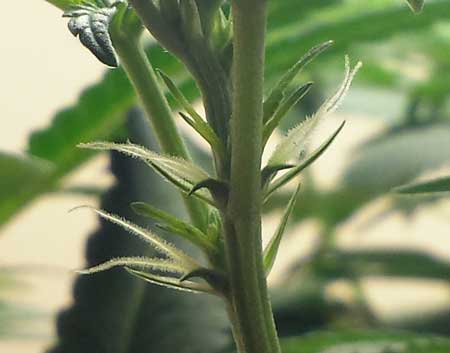
It’s too late to top this autoflowering plant to be topped. Way too many hairs popping up everywhere!
This plant is a week or two into bud development. Never top a plant with buds that have developed this far.
When is it a Bad Idea to Train an Auto-Flowering Plant?
Auto plants are on a very tight time schedule in the vegetative stage, and therefore plant training isn’t necessarily the best idea for plants that are already sick or stunted since they likely won’t have time to recover.
Don’t Train an Auto if…
- Plant is Sick, Stunted, or Slow-Growing
- Plant is older than 4-5 weeks old
- Plant has already started forming little budlets (more than two white hairs at the base of each leaf)
- after this point, only use low-stress bending and securing stems down to keep the plant the shape you want
With an auto-flowering strain, you generally have about a month to create the main shape of the plant. After that, it will start flowering and although it will continue getting taller, you want to let the plant focus on fattening the buds as opposed to a whole lot of further training.
If you’re not sure whether to top your plant, it’s recommended to stick to bending as it can achieve similar results without any risk of further stunting your plant. Notice how the main stem of this plant was bent all the way over and tied down.
That being said, almost every other plant training method (topping or FIMing, low stress training, supercropping and Sea of Green) can be used on auto-flowering plants as long as you watch the plant closely for signs of stress and make sure you let the plant get big enough to produce good yields in the flowering stage!
Extra Growing Tips for Autos
Low to Medium Nutrient Needs
Whether you grow in soil, coco coir, or a full hydroponic setup, auto plants often tend to prefer relatively low levels of nutrients compared to many other cannabis strains.
When it comes to adding extra bottled nutrients, start at 1/2 strength of the recommended dose or less, and only add higher levels of nutrients if needed. In hydro use “vegetative” nutrients until you see “budlets” (little bunches of white hairs) which is often around 4-5 weeks. In good soil, you don’t need to add any nutrients during the vegetative stage. After the first signs of buds, start adding “flowering” nutrients at very low strength (1/2 strength to start).
Potted Auto Plants
Potted auto plants tend to do best in an airy potting mix with lots of drainage (plenty of drainage holes, and something like perlite to help add more drainage to your growing medium). This helps makes sure roots get plenty of oxygen so plants grow as fast as possible.
With any soil mix, it’s recommended to have about 20-30% extra perlite for increased drainage.
Read a simple soil grow guide for autos
However, I use coco coir to get faster growth than soil
Strain & Final Size Have an Effect on Training
The final size of your auto plants is largely dependent on the strain you get. Some cannabis autoflowering strains have been bred to grow extremely short – less than 1-2 feet. Other strains can grow taller, up to 4 feet tall, or even more.
Although most auto strains start flowering at just 3-4 weeks, some strains take up to 8 weeks (or even longer) to auto. Often, long-flowering auto strains are labeled as “Super Autos” or “XXL” but you should still read the breeder description to fully know what to expect as far as timelines and height.
If you have a plant that is not “auto-ing” as soon as you want, you can put it on a 12/12 light schedule and it will usually start flowering in 1-2 weeks just like a photoperiod plant.
These two auto-flowering plants are the same age and were grown in the same setup! Genetics makes a huge difference to your final results, so it’s important to pick the right auto-flowering strain! The small plant is White Widow Auto & the huge plant is Onyx Auto.
Auto-flowering pic by Vapo69
These two auto-flowering plants are also the same age and grown in the same environment. The itty bitty plant (front bottom left, it’s easy to miss it’s so small!) is Auto Chemdawg. The huge plant is Super Lemon Haze Auto.
Auto-flowering pic by henry tate
As a general rule of thumb, auto plants tend to double or triple in size from when they first start showing signs of flowering/budding (usually when plants are about 3-4 weeks old from seed).
Final Height of Auto-Flowering Plants is Often ~2-3 Times the Height When the Plant First Started Showing Pistils/Hairs
An auto-flowering plant is usually “full size” at just 6-7 weeks from seed. For example, these autos are 6 weeks old and didn’t get any taller, even though buds are still fattening and harvest is still several weeks away!
A stunted autoflower won’t produce much bud because it never gets big!
Bend too-tall branches down and away from the center of your plant
Plant training is a tactic that helps cannabis growers increase yields indoors by exposing more buds to strong, direct light from the grow light.
When growing any cannabis plants indoors, it’s recommended to at least use bending to open up the plant so it grows flat and wide
A view from the side just before harvest so you can see how those plants were trained to grow flat and wide. Training allows all the bud sites to grow directly under the light, so they get as big as possible
See the full grow journal with these autos
Recommended Auto-Flowering Strains and Breeders
Which breeders can you trust for good auto-flowering marijuana seeds? These auto breeders have dedicated themselves to developing great auto-flowering strains, and have gained popularity for their consistency and quality.
There are many other breeders that offer auto-flowering seeds, but the breeders listed have become famous for breeding some of the best auto seeds when it comes to ease of growth, potency and yields. Let us know if you believe there’s an auto-flowering cannabis breeder we should add to this list!
Recommended Autoflowering Breeders
Many breeders produce great auto-flowering strains (Barney’s Farm, etc.), but the following breeders stand out for consistency and potency. Click the name of the breeder to see a list of their currently available auto-flowering strains.
- Bomb Seeds – sparkly and potent buds. Bomb Seeds breeds both autoflowering and photoperiod cannabis seeds, but here’s a list of just their autoflowering strains. I’ve grown their THC Bomb Auto multiple times and I was beyond impressed with the yields, bud potency, and just overall nice look of the buds. Their other auto-flowering “bomb” strains are great too, including Berry Bomb Auto (berry flavor), Cherry Bomb Auto (cherry flavor), and Big Bomb Auto (super high yielding).
- Buddha Seeds – feel-good potency, great choice for growers who struggle with anxiety.
- Dutch Passion – Excellent yields (some of the best yields for auto-flowering strains that I’ve grown). Smooth, classic effects on their buds. Their Cinderella Jack Auto is extra potent.
- FastBuds – Fast and potent. Fastbuds have gone “all in” for auto-flowering strains. Their Pineapple Express and LSD-25 Auto strains are popular and easy to grow. In fact, every auto strain I’ve grown from Fastbuds has produced above-average quality buds in smell, appearance, and potency. Highly recommended.
- G13 Labs – Consistent good results. Plants closely match the strain descriptions, so you get what you expect.
- Mephisto – unfortunately, they can’t seem to scale up their operations and strains sell out constantly (keep checking back or sign up for the newsletter on the bottom of the Mephisto website to get updates when they release batches of seeds)
- Nirvana – All their strains are easy to grow. Their Auto Lemon OG Haze makes beautiful high-THC buds with a medium amount of CBD, while their Auto Northern Light is popular because it has a relatively low smell.
- Royal Queen Seeds – Buds always come out beautiful (they look just like the pictures) and smell great.
- Seedsman – The Seedsman website offers seeds from many different breeders, but they also sell in-house “Seedsman” brand auto-flowering seeds, which grow fast with high-quality buds
- Sweet Seeds – Spanish genetics with beautiful and colorful strains like Cream Caramel Auto
- Victory Seeds – Dense high-quality buds that look and smell like photoperiod strains
Here are some pictures of autoflowering cannabis plants I’ve grown from these breeders.
Cinderella Jack Auto by Dutch Passion makes extra-potent, rock-hard buds with above-average yields. This little plant produced several ounces by itself.
Zkittlez Auto by Fastbuds – big yields and bud effects are lovely
Auto Lemon OG Haze by Nirvana makes beautiful buds and plants are easy to grow
I’ve grown multiple THC Bomb Auto plants (by Bomb Seeds) and they always respond well to training and produce great bud quality
Buds come out super sparkly on the THC Bomb autos!
I hope you enjoyed this tutorial as much as I would have when I first started growing with autoflowering strains. Send us pics of your favorite autoflowering plants for a chance to be featured in our weekly newsletter’s “trophy pics of the week” section.

